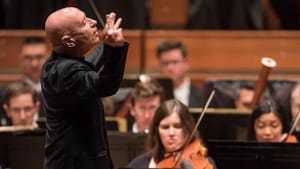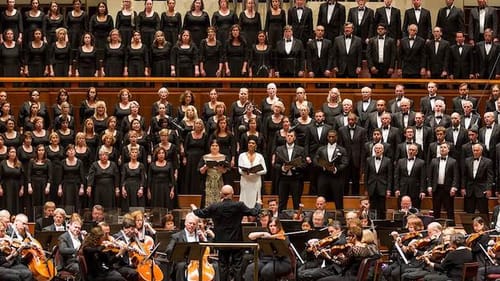Stay in the Loop
BSR publishes on a weekly schedule, with an email newsletter every Wednesday and Thursday morning. There’s no paywall, and subscribing is always free.
Christoph Eschenbach passes the baton
National Symphony Orchestra presents Beethoven's Ninth Symphony

This week, the National Symphony Orchestra marks the final performances of Christoph Eschenbach as music director and principal conductor, a position he has held since its 2010-2011 season. (Eschenbach will return as conductor laureate for the next three seasons.)
Broad Street Review readers will remember Eschenbach from his contentious tenure with the Philadelphia Orchestra. His stay in the nation’s capital brought with it familiar controversies. Performances were sometimes wildly successful and sometimes less so. In the absence of consistent, strong performances, however, controversy does not sell tickets; the number of empty seats in the concert hall remains discouraging.
As a Philadelphian with strong ties (and season tickets) in Washington, D.C., I’ve seen Eschenbach bring out the great and mediocre in both orchestras. But he has devoted his life to music. At age 77, he steps down from what will doubtless prove to be his last stint as musical director of a major orchestra. It’s time to celebrate the brilliance with which he can still astonish us today.
A Chinese Zodiac
Bright Sheng’s Zodiac Tales took a wandering path to this week’s performance. Under Eschenbach’s direction, the Philadelphia Orchestra commissioned the piece in 2005, and it is dedicated to the maestro. However, it was first performed by the Detroit Symphony Orchestra, led by Leonard Slatkin, who preceded Eschenbach as music director of the National Symphony. Sheng subsequently revised the piece, and Eschenbach conducted the premiere of the (revised) music he had commissioned more than a decade earlier.
Zodiac Tales tells the stories of six animals in the Chinese zodiac. A programmatic piece should tell its story without explanation, and this one succeeds both as contemporary music and as instrumental storytelling. Part one, “The Rain God,” represents a dragon in the crashing percussion of thunder. Later in the section, one hears the sound of water, which suits the dragon’s rain aspect exactly. In part two, “Of Mice and Cats,” the music holds a sense of anticipation and skittering, followed by the cat’s brass.
As a fan of percussion I was fascinated by the wide array of drums, gongs, cowbells, guiro, tam tams, glockenspiels, and other instruments Sheng uses to good advantage. But this was not the draw that led to one of the National Symphony’s rare sellout performances.
Powerful Goodbye
Beethoven’s Ninth Symphony lured many to the Kennedy Center’s Concert Hall. Eschenbach began his first season at the National Symphony with the Ninth, and he completed his run as it had begun. Afterward, he said he had always started the work with a clean score, not relying on the past but looking for something new. Would Eschenbach lay down a definitive statement about his tenure with the orchestra, or would this feel a bit like watching a rerun?

With the first strains of the first movement, it was clear this was a special night. The strings played on our nerves, drawing out tension. In his comments after the performance, Eschenbach said Beethoven did not set a specific tempo; rather, his markings set a pulse. Using the flexible tempo for which he is known, Eschenbach drew on that insistent heartbeat.
The second movement, a long, dramatic scherzo, upped the pace, building tension again with complex, driving rhythms. The orchestra played it like a howling call to arms in an ongoing argument with God, until Beethoven and Eschenbach dropped into a mournfully quiet adagio.
The fourth movement returned to that exquisite tension of the first, recalling the thunderous passage of the second and gently introducing the simple opening strains of choral section. Then the glorious voice of bass Solomon Howard rang out. The Choral Arts Society of Washington produces a gorgeous sound, and soloists Leah Crocetto (soprano), J’nai Bridges (mezzo-soprano), and Joseph Kaiser (tenor) added to the whole. I was riveted to my seat by the onslaught of glorious, joyful music.
The performance ended with a 10-minute standing ovation. In part, this reflects the moment: a music director stepping down marks the end of an era for an orchestra, literally a passing of the baton. But neither duty nor history brought us to our feet. If a symphony is an argument with God, Beethoven is the only composer to have won the argument, and Eschenbach showed us how he did it.
To watch this concert (available free until September 16, 2017), recorded live at the Kennedy Center in its entirety, click here.
What, When, Where
National Symphony Orchestra. Bright Sheng, Zodiac Tales; Beethoven, Ninth Symphony. June 15-17, 2017, at the John F. Kennedy Center for the Performing Arts, 2700 F Street NW, Washington, D.C. (202) 467-4600 or kennedy-center.org/nso.
Sign up for our newsletter
All of the week's new articles, all in one place. Sign up for the free weekly BSR newsletters, and don't miss a conversation.
 Camille Bacon-Smith
Camille Bacon-Smith